Verdict
Solid, reliable, and ultimately recommended. The Sharp 55FJ7K Roku TV doesn’t wow as much as other Roku models have, but it is a mostly consistent performer that comes with an accessible interface and good set of features for video and audio streaming.
Pros
- Simple to operate
- Affordable price
- Dolby Vision support
- HDMI eARC compatibility
Cons
- Inconsistent black levels
- Not the brightest HDR image
- Better performance can be had for similar outlay
- No Atmos support for apps
-
AV1 supportAV1 codec support for higher quality streaming -
Dolby Vision HDRSupport’s Dolby’s HDR format for improved contrast and brightness -
Roku TVAccess to a wide range of streaming apps
Introduction
Sharp is the latest brand to join the ranks of Roku TVs. The Sharp 55FJ7K is an affordable, mass market model with an emphasis on streaming content.
But with so many Roku TVs now available, it begs the question of why should you buy the Sharp over others? Dolby Vision is one plus, and compatibility with AV1 streaming, eARC and HDMI 2.1 are others that might make you plump for this TV over the legion of other Roku screens.
Design
- Tidy looks
- Easy to assemble
- Below average viewing angles
Out of its packaging, the Sharp 55FJ7K looks very much like a Roku TV – and that’s a positive.
Its appearance is tidy, and assembly is quick – it’s less than three minutes to get it upright. It looks not unlike the Metz Roku model, though the feet are further out, the connections round the back are both side- and downward-facing, and the power cable is captive, so it can’t be detached.
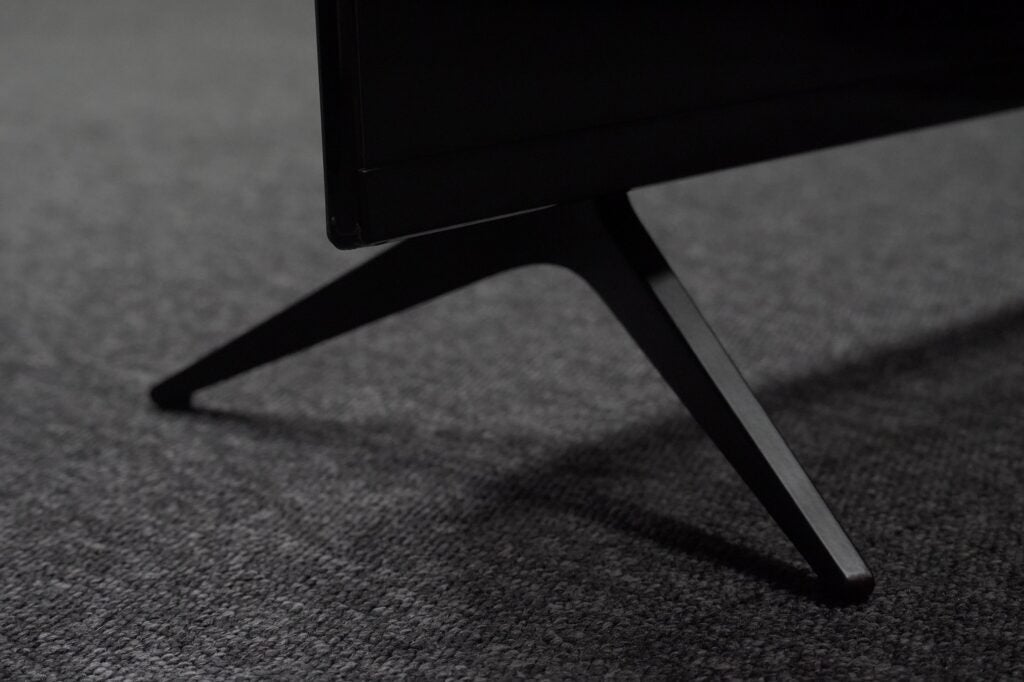
Like its Metz Roku stablemate, the screen is reflective, so it’s best placed away from direct lights. Viewing angles are below average – I don’t have to shift far across the settee for colours to lose saturation and black levels to slump. For a 55-inch screen that’s more of a disappointment than it was on the 43-inch Metz Roku.
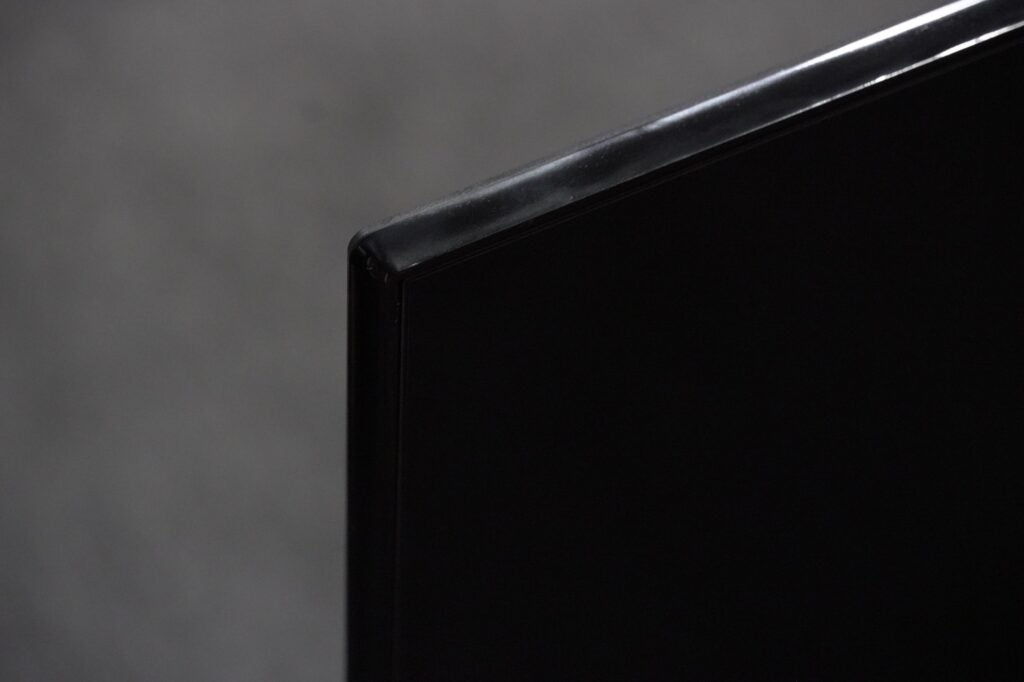
Operating System
- Easy to traverse
- Mobile app support
- Lots of streaming apps
Visually orientated and easily navigable, the Roku interface won’t win awards for being the most attractive, but this is as fuss-free and accessible as TV interfaces come.
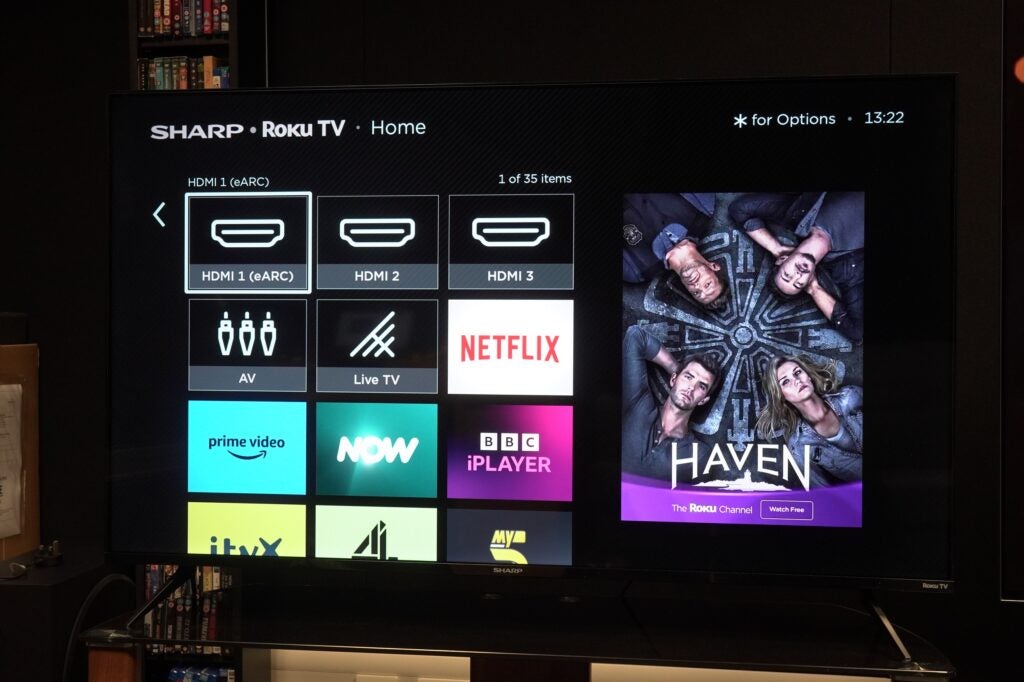
The sections are separated into Home, Save List, Freeview Play, Search, Streaming Store, and Settings, and flicking through them is responsive with no noticeable lag. The mobile app is even better. Faster, slicker, and with more content at your fingertips. Private listening is also integrated with a pair of headphones. Have a family of Roku devices at home? They can all be managed through the app too.
Customisation of the home screen is possible by editing the names of inputs and shuffling apps around. The What to Watch feature should be rolling out to this and other Roku TV models in the early months of 2024, offering users personalised rows of programming based on trending content, subscriptions and viewing habits.
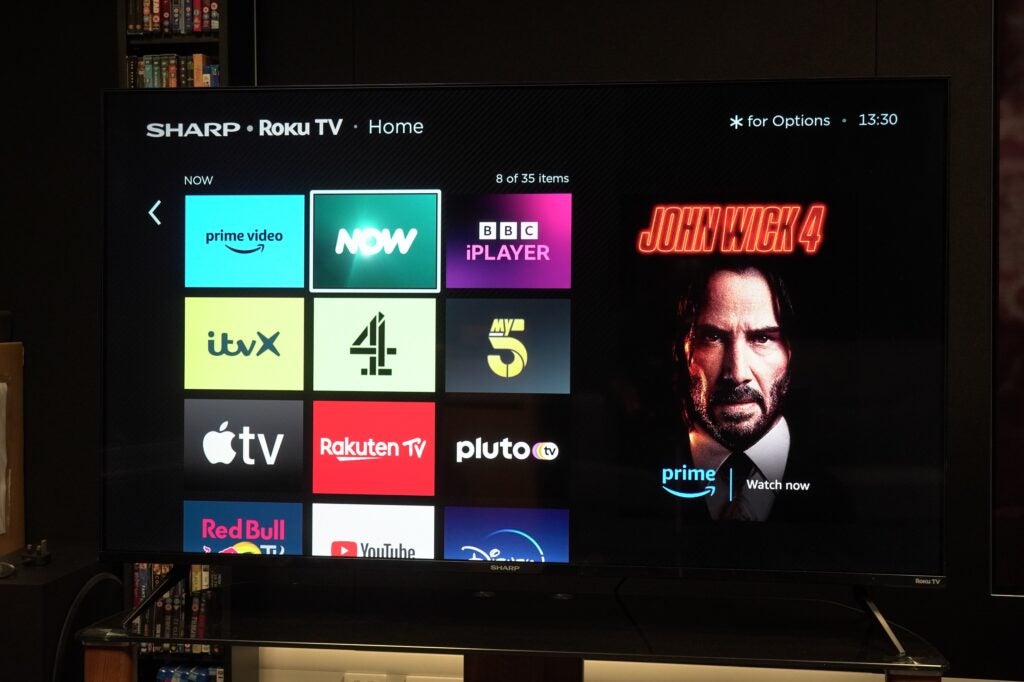
Roku has never lacked for apps and all the main UK catch-up and on-demand options feature through Freeview Play, as well as the usual suspects in Netflix, Disney+, Apple TV+, Prime Video, Spotify, and many more.
The picture/sound menu is largely the same save for a few differences such as fewer audio settings on the Sharp Roku than there were on the Metz.
Even more of a disappointment is the cardboard-esque remote control. It feels so cheap to handle; the spongy button presses are so basic that I’d prefer not to use it. It has shortcuts to Prime Video, Apple TV+, Freeview Play, Spotify, and Netflix, though I still don’t understand why there isn’t one for source inputs.
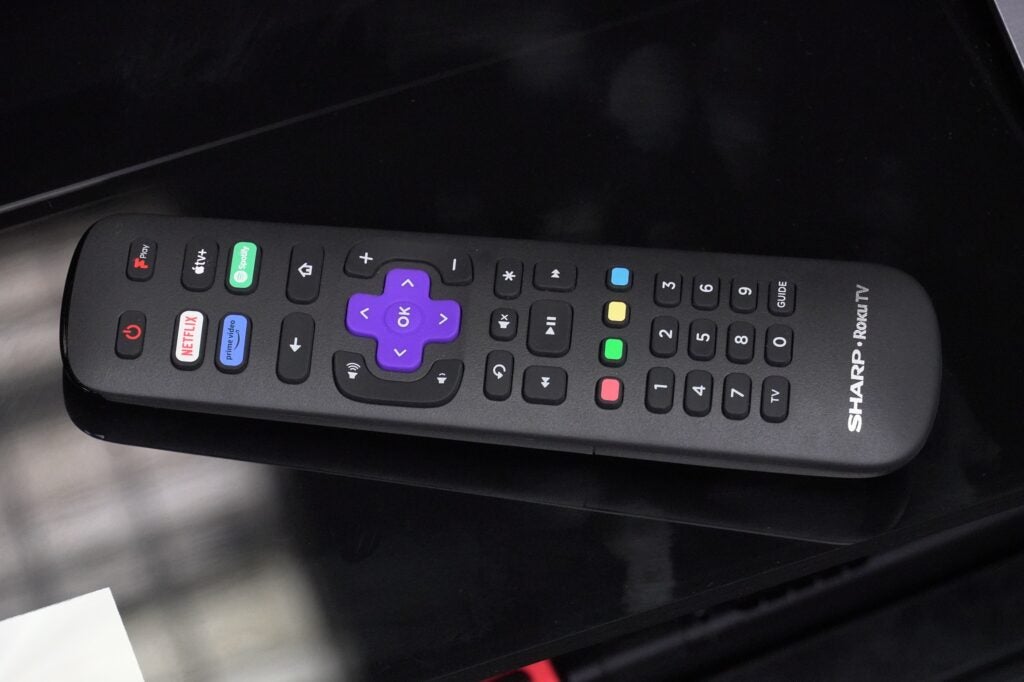
Features
- Dolby Vision HDR support
- AV1 streaming
- HDMI 2.1 compatible
AV compatibility for the popular streaming apps is up and down. Prime Video says it plays Dolby Vision HDR and Dolby Atmos audio, but when I play content it’s just in HDR. Netflix supports Dolby Vision but not Atmos, and it’s the same with Disney+ (5.1 audio) and Apple TV+, which I couldn’t confirm on the TV if it supported Atmos.
The picture painted above is one that doesn’t include Dolby Atmos, which is odd as the Sharp 55FJ7K has a HDMI eARC input that supports HDMI 2.1. I’m speculating the Sharp can pass-through Atmos from a connected source to a soundbar, but the apps can’t.
Supported audio formats include Dolby Digital, Dolby Digital+, and Dolby AC-4 through its 20W audio system, while HDR covers Dolby Vision, HDR10, and HLG (the latter for TV broadcasts). The AV1 codec is there for higher quality video streaming.
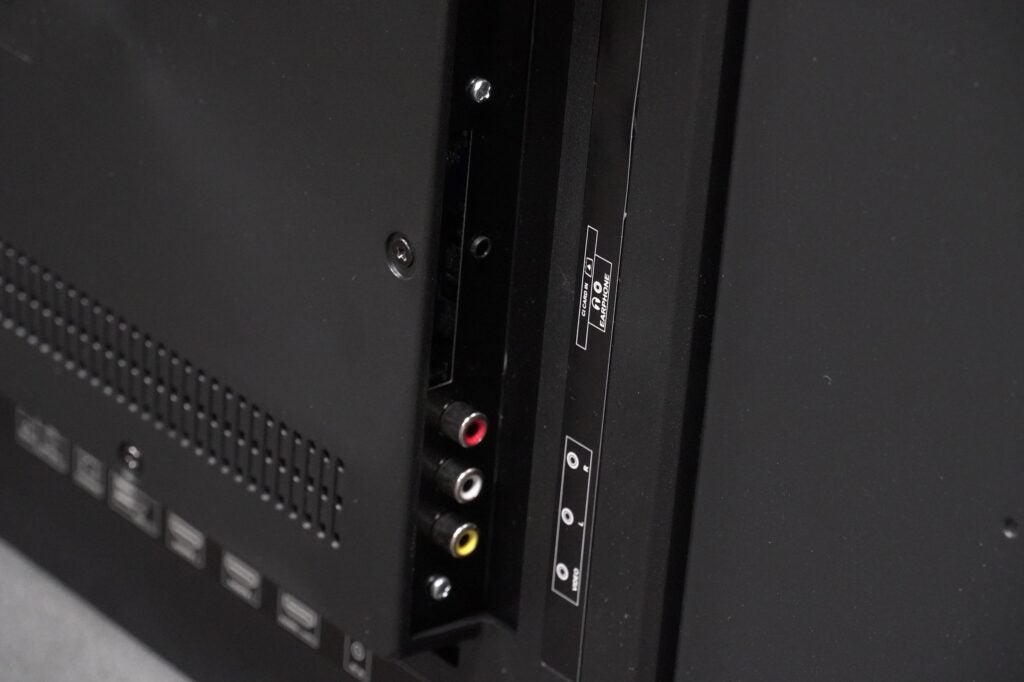
Roku TVs don’t tend to support MEMC – motion processing – but the Sharp features Active Motion 400, although I can’t see how to enable or disable it.
Connectivity covers three HDMI 2.1 inputs at 4K/60Hz, three RCA, two USB, Ethernet, and antennae inputs, plus a digital optical audio and headphone/line outputs. Wi-Fi (with AirPlay 2 support) is included but there’s no Bluetooth.
I measured input lag at 11.8ms, quick enough to handle FPS and other fast-twitch genres. There’s no built-in voice assistant, but there are ‘Works with’ variants of Amazon, Apple, and Google’s voice control that require an external speaker to operate.
Picture Quality
- Slightly inconsistent black levels
- Balanced HDR colour performance
- Upscales solidly
The Sharp Roku’s picture performance is solid, with the key word being balance. The 55FJ7K doesn’t produce images with flair, but it is consistent and reminds me of Sharp’s 65EQ3EA – and it picks up some of the same issues too.
It hits the same brightness peaks as TCL 55RC630K, hitting 377 nits in Standard mode, 391 in Film mode and 378 nits in Vivid mode. There’s not a big variance in brightness across modes.
Colour accuracy appears good out the box – better than the Metz Roku whether I’m eyeballing the screen or referring to colour measurements; and while it doesn’t boast the punchiest performance, colours take on an agreeable sense of balance.
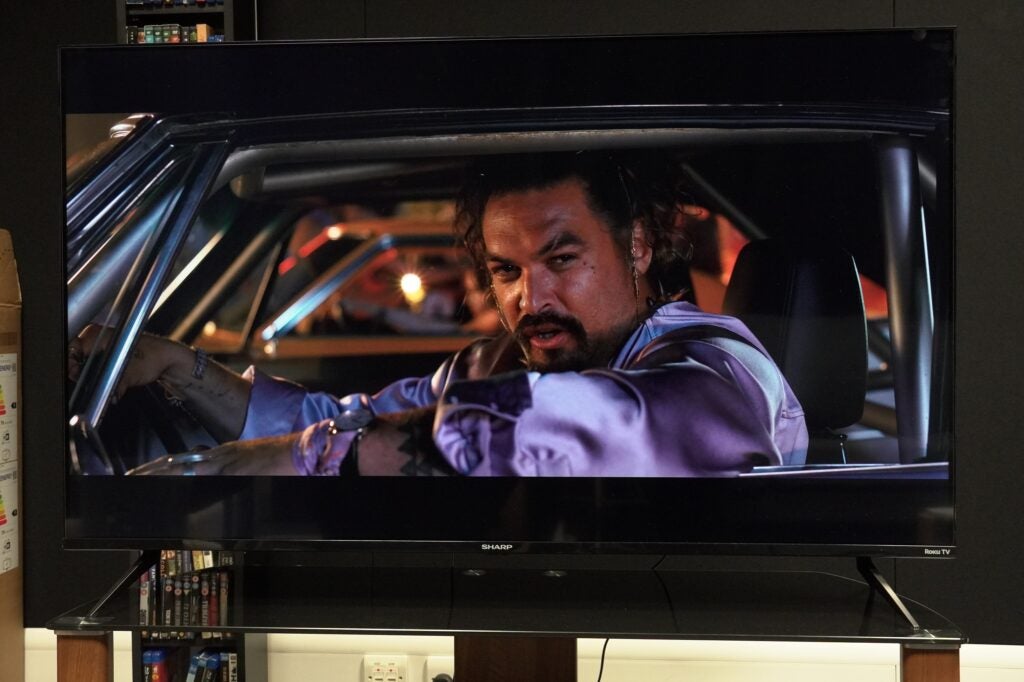
Sitting next to an LG OLED and watching Loki season 2 on both, I’d say the Sharp produces more natural complexions than the LG, which veer towards a reddish hue. It’s not the sharpest with 4K content, and that’s applicable to both video streams and 4K Blu-rays.
With Lessons in Chemistry (Apple TV+) colours seem a little off. Blacks are a little green, scenes set at nighttime look slightly washed out – blacks lack a degree of depth, highlights are dim, and contrast suffers as a result. It’s fine for a budget TV, but it could be reasonably better.
Switching to Dolby Vision Dark improves black levels somewhat, but they’re still not as robust as I’d like. The TV puts in the opposite Dolby Vision performance with 4K Blu-rays of It: Chapter One and Fast X, with solid black levels and good backlight control.
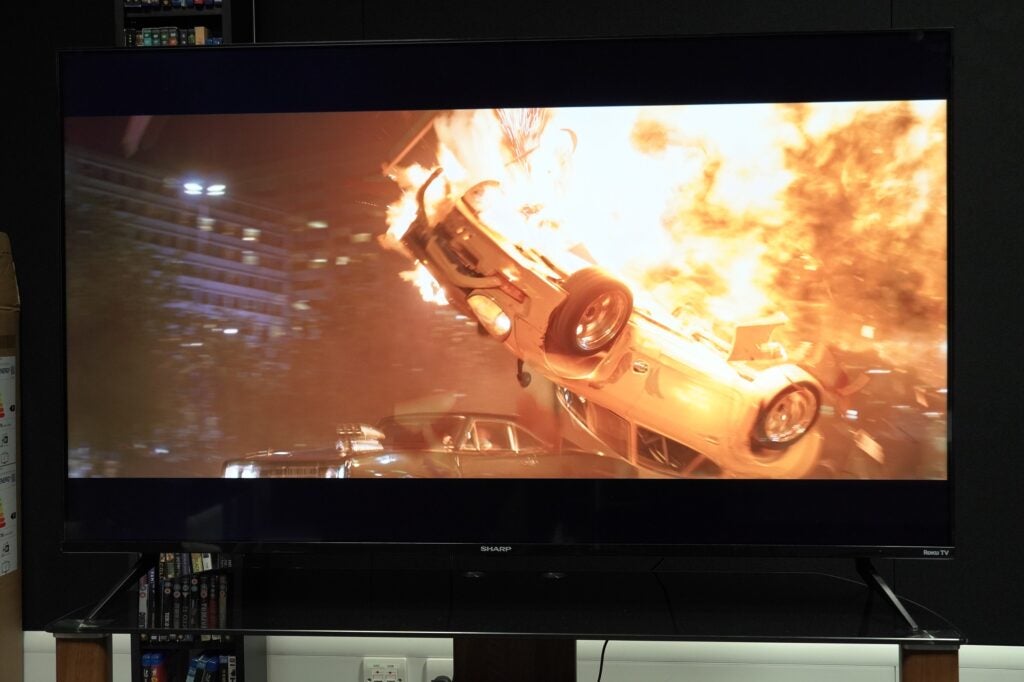
The scenes in the sewers from It are handled well – better than I expected to be honest – and the fiery explosions in a street race from Fast X are quite literally illuminating, but you’ll get better, more impactful bursts of brightness if you shop at higher prices.
The issues I’ve mentioned aren’t ruinous, but if I were to choose between this Sharp TV and the TCL Roku when it comes to HDR, I’d choose the latter.
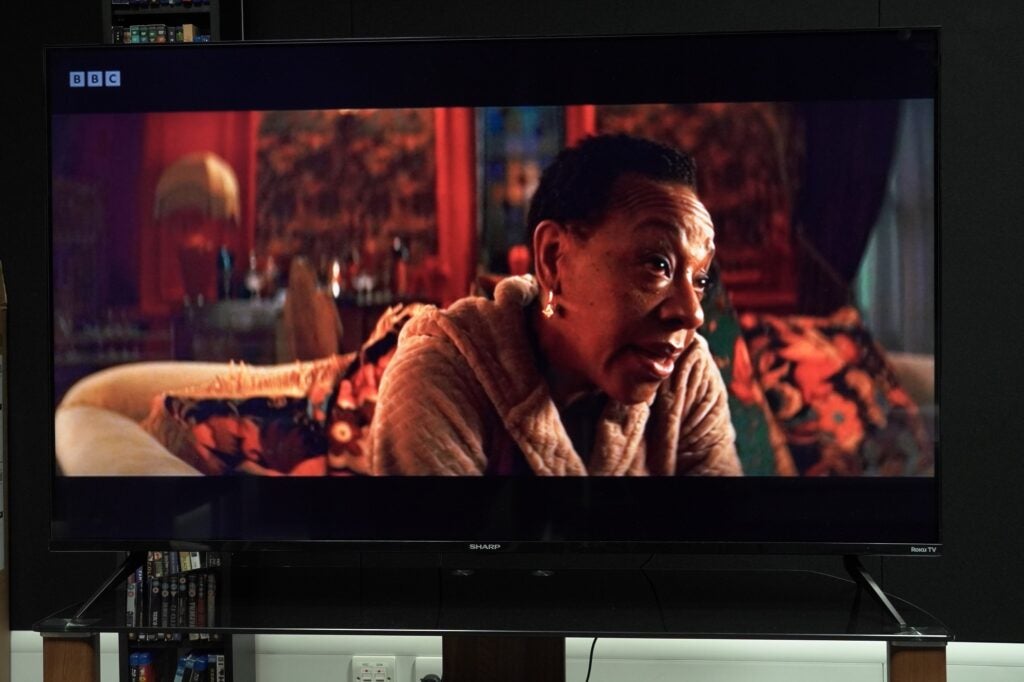
As is often the case with budget TVs, the Sharp 55FJ7K is on firmer ground with HDR SDR content.
Watching The Following Events Are Based on a Pack of Lies (iPlayer), the interior of Cheryl Harker’s house is full of rich shades of reds and golds, complexions are strongly conveyed. It’s an attractive image for sure.
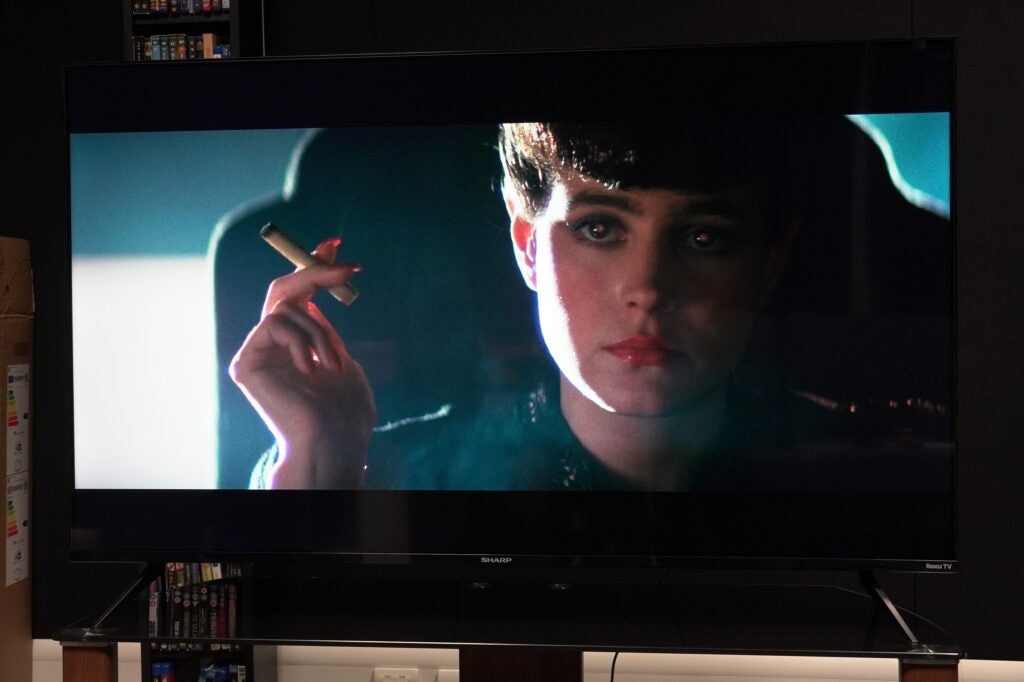
Blade Runner in HD features respectably fleshed-out colours, extracting decent levels of detail from actors’ faces. There are slightly blue-ish blacks in places, and it’s not the sharpest image (likely baked into the source) but it is fine.
A DVD of Hellboy: The Golden Army is unarguably soft, but the noise in the image is steadily managed. Like with a Pack of Lies, the richness of the colours in the fairy world (reds, oranges, and blacks) really stand out. Edges are drawn smooth enough, though when it’s dealing with finer details, the Sharp falls prey to noise. It’s solid – there’s that word again – and it sums up the Sharp 55FJ7K’s performance.
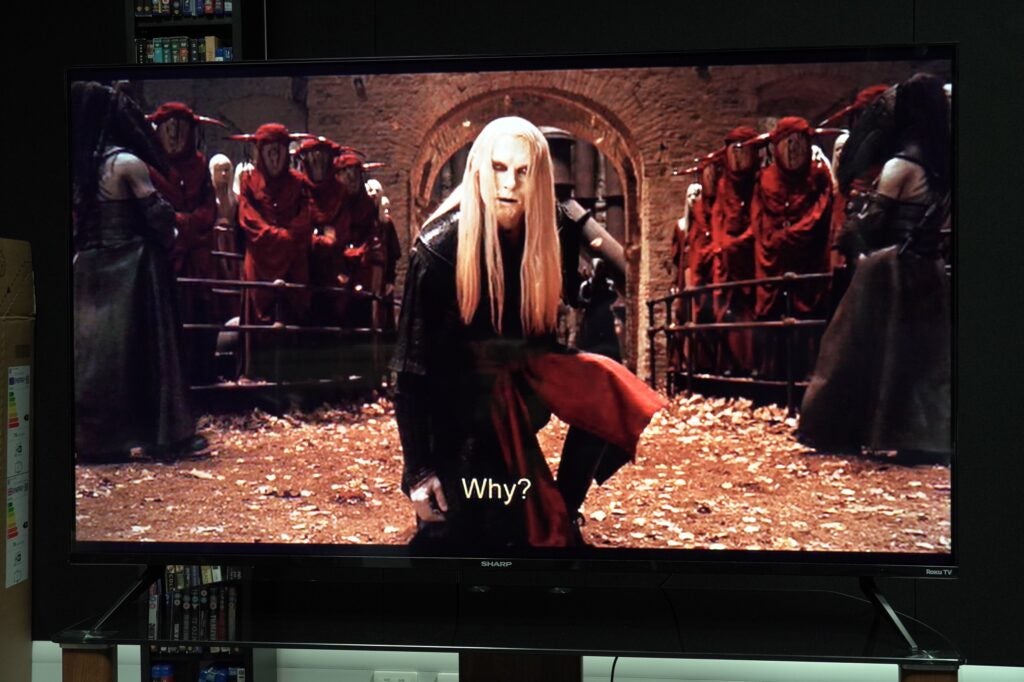
Sound Quality
- Hollow bass
- Solid dialogue clarity
- Auto/Standard the mode offers best performance
There’s not much, if any, dynamism to this TV’s sound, nor does the audio expand beyond the (smart-looking) borders of the TV.
Bass output has a hollow thump to it. In It: Chapter One, the jump scares don’t land with much force which deadens the excitement.
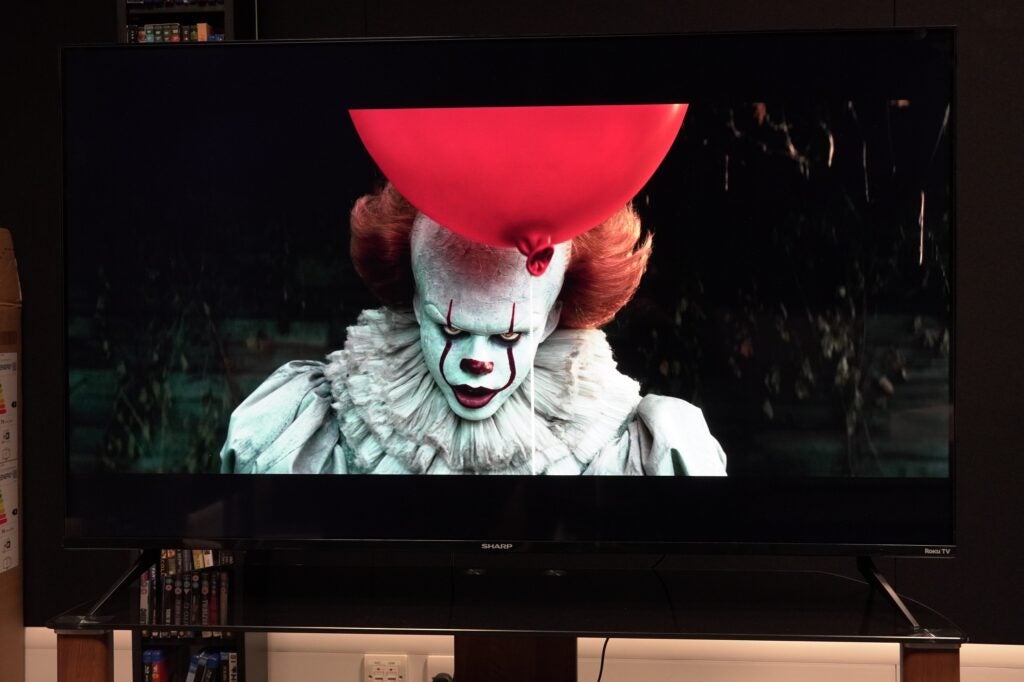
The Dialogue Enhancer is reliably consistent if you can’t hear some dialogue, but I did find that dialogue in Fast X sounded slightly muffled and lacking sharpness. The TV seems to err towards a warm, smooth output, which I don’t think works for some audio modes.
Stick with Auto/Standard as it is the clearest, sharpest, and best-defined mode – and it sounds bigger too. If not, there’s always an affordable soundbar to give this TV the boost it needs.
Latest deals
Should you buy it?
A reliably solid Roku TV
A few picture inconsistencies aside, this Sharp Roku delivers a balanced picture and a good suite of features, though the TCL RC630K is better in my estimation.
If you want better picture and sound
The TCL RC630K is a better option in the A/V department, and still available for £399. It’s our best budget TV of 2023 for a reason.
Final Thoughts
Solid and respectable are the words that come to my mind regarding the Sharp 55FJ7K Roku TV. It’s a perfectly fine entry into the Roku TV line-up.
It reminds me of the Hisense Roku A7200G with its understated yet colourful picture, but the seeming lack of built-in Dolby Atmos is odd when looking at the feature-set, and the set’s black levels can be inconsistent depending on the source.
The TCL Roku wasn’t perfect, but it did raise the level for Roku TVs. This Sharp doesn’t reach it, but that’s not to say you don’t get plenty of bang for your buck. Check out our best cheap TV guide for more options.
How we test
We test every television we review thoroughly over an extended period of time. We use industry standard tests to compare features properly. We’ll always tell you what we find. We never, ever, accept money to review a product.
Find out more about how we test in our ethics policy.
Benchmarked with Spears and Munsil test disc
Tested across several weeks
Tested with real world use
FAQs
The Sharp 55FJ7K is compatible with the VESA 400 x 300mm wall-mount.
Trusted Reviews test data
Verdict
Solid, reliable, and ultimately recommended. The Sharp 55FJ7K Roku TV doesn’t wow as much as other Roku models have, but it is a mostly consistent performer that comes with an accessible interface and good set of features for video and audio streaming.
Pros
- Simple to operate
- Affordable price
- Dolby Vision support
- HDMI eARC compatibility
Cons
- Inconsistent black levels
- Not the brightest HDR image
- Better performance can be had for similar outlay
- No Atmos support for apps
-
AV1 supportAV1 codec support for higher quality streaming -
Dolby Vision HDRSupport’s Dolby’s HDR format for improved contrast and brightness -
Roku TVAccess to a wide range of streaming apps
Introduction
Sharp is the latest brand to join the ranks of Roku TVs. The Sharp 55FJ7K is an affordable, mass market model with an emphasis on streaming content.
But with so many Roku TVs now available, it begs the question of why should you buy the Sharp over others? Dolby Vision is one plus, and compatibility with AV1 streaming, eARC and HDMI 2.1 are others that might make you plump for this TV over the legion of other Roku screens.
Design
- Tidy looks
- Easy to assemble
- Below average viewing angles
Out of its packaging, the Sharp 55FJ7K looks very much like a Roku TV – and that’s a positive.
Its appearance is tidy, and assembly is quick – it’s less than three minutes to get it upright. It looks not unlike the Metz Roku model, though the feet are further out, the connections round the back are both side- and downward-facing, and the power cable is captive, so it can’t be detached.

Like its Metz Roku stablemate, the screen is reflective, so it’s best placed away from direct lights. Viewing angles are below average – I don’t have to shift far across the settee for colours to lose saturation and black levels to slump. For a 55-inch screen that’s more of a disappointment than it was on the 43-inch Metz Roku.

Operating System
- Easy to traverse
- Mobile app support
- Lots of streaming apps
Visually orientated and easily navigable, the Roku interface won’t win awards for being the most attractive, but this is as fuss-free and accessible as TV interfaces come.

The sections are separated into Home, Save List, Freeview Play, Search, Streaming Store, and Settings, and flicking through them is responsive with no noticeable lag. The mobile app is even better. Faster, slicker, and with more content at your fingertips. Private listening is also integrated with a pair of headphones. Have a family of Roku devices at home? They can all be managed through the app too.
Customisation of the home screen is possible by editing the names of inputs and shuffling apps around. The What to Watch feature should be rolling out to this and other Roku TV models in the early months of 2024, offering users personalised rows of programming based on trending content, subscriptions and viewing habits.

Roku has never lacked for apps and all the main UK catch-up and on-demand options feature through Freeview Play, as well as the usual suspects in Netflix, Disney+, Apple TV+, Prime Video, Spotify, and many more.
The picture/sound menu is largely the same save for a few differences such as fewer audio settings on the Sharp Roku than there were on the Metz.
Even more of a disappointment is the cardboard-esque remote control. It feels so cheap to handle; the spongy button presses are so basic that I’d prefer not to use it. It has shortcuts to Prime Video, Apple TV+, Freeview Play, Spotify, and Netflix, though I still don’t understand why there isn’t one for source inputs.

Features
- Dolby Vision HDR support
- AV1 streaming
- HDMI 2.1 compatible
AV compatibility for the popular streaming apps is up and down. Prime Video says it plays Dolby Vision HDR and Dolby Atmos audio, but when I play content it’s just in HDR. Netflix supports Dolby Vision but not Atmos, and it’s the same with Disney+ (5.1 audio) and Apple TV+, which I couldn’t confirm on the TV if it supported Atmos.
The picture painted above is one that doesn’t include Dolby Atmos, which is odd as the Sharp 55FJ7K has a HDMI eARC input that supports HDMI 2.1. I’m speculating the Sharp can pass-through Atmos from a connected source to a soundbar, but the apps can’t.
Supported audio formats include Dolby Digital, Dolby Digital+, and Dolby AC-4 through its 20W audio system, while HDR covers Dolby Vision, HDR10, and HLG (the latter for TV broadcasts). The AV1 codec is there for higher quality video streaming.

Roku TVs don’t tend to support MEMC – motion processing – but the Sharp features Active Motion 400, although I can’t see how to enable or disable it.
Connectivity covers three HDMI 2.1 inputs at 4K/60Hz, three RCA, two USB, Ethernet, and antennae inputs, plus a digital optical audio and headphone/line outputs. Wi-Fi (with AirPlay 2 support) is included but there’s no Bluetooth.
I measured input lag at 11.8ms, quick enough to handle FPS and other fast-twitch genres. There’s no built-in voice assistant, but there are ‘Works with’ variants of Amazon, Apple, and Google’s voice control that require an external speaker to operate.
Picture Quality
- Slightly inconsistent black levels
- Balanced HDR colour performance
- Upscales solidly
The Sharp Roku’s picture performance is solid, with the key word being balance. The 55FJ7K doesn’t produce images with flair, but it is consistent and reminds me of Sharp’s 65EQ3EA – and it picks up some of the same issues too.
It hits the same brightness peaks as TCL 55RC630K, hitting 377 nits in Standard mode, 391 in Film mode and 378 nits in Vivid mode. There’s not a big variance in brightness across modes.
Colour accuracy appears good out the box – better than the Metz Roku whether I’m eyeballing the screen or referring to colour measurements; and while it doesn’t boast the punchiest performance, colours take on an agreeable sense of balance.

Sitting next to an LG OLED and watching Loki season 2 on both, I’d say the Sharp produces more natural complexions than the LG, which veer towards a reddish hue. It’s not the sharpest with 4K content, and that’s applicable to both video streams and 4K Blu-rays.
With Lessons in Chemistry (Apple TV+) colours seem a little off. Blacks are a little green, scenes set at nighttime look slightly washed out – blacks lack a degree of depth, highlights are dim, and contrast suffers as a result. It’s fine for a budget TV, but it could be reasonably better.
Switching to Dolby Vision Dark improves black levels somewhat, but they’re still not as robust as I’d like. The TV puts in the opposite Dolby Vision performance with 4K Blu-rays of It: Chapter One and Fast X, with solid black levels and good backlight control.

The scenes in the sewers from It are handled well – better than I expected to be honest – and the fiery explosions in a street race from Fast X are quite literally illuminating, but you’ll get better, more impactful bursts of brightness if you shop at higher prices.
The issues I’ve mentioned aren’t ruinous, but if I were to choose between this Sharp TV and the TCL Roku when it comes to HDR, I’d choose the latter.

As is often the case with budget TVs, the Sharp 55FJ7K is on firmer ground with HDR SDR content.
Watching The Following Events Are Based on a Pack of Lies (iPlayer), the interior of Cheryl Harker’s house is full of rich shades of reds and golds, complexions are strongly conveyed. It’s an attractive image for sure.

Blade Runner in HD features respectably fleshed-out colours, extracting decent levels of detail from actors’ faces. There are slightly blue-ish blacks in places, and it’s not the sharpest image (likely baked into the source) but it is fine.
A DVD of Hellboy: The Golden Army is unarguably soft, but the noise in the image is steadily managed. Like with a Pack of Lies, the richness of the colours in the fairy world (reds, oranges, and blacks) really stand out. Edges are drawn smooth enough, though when it’s dealing with finer details, the Sharp falls prey to noise. It’s solid – there’s that word again – and it sums up the Sharp 55FJ7K’s performance.

Sound Quality
- Hollow bass
- Solid dialogue clarity
- Auto/Standard the mode offers best performance
There’s not much, if any, dynamism to this TV’s sound, nor does the audio expand beyond the (smart-looking) borders of the TV.
Bass output has a hollow thump to it. In It: Chapter One, the jump scares don’t land with much force which deadens the excitement.

The Dialogue Enhancer is reliably consistent if you can’t hear some dialogue, but I did find that dialogue in Fast X sounded slightly muffled and lacking sharpness. The TV seems to err towards a warm, smooth output, which I don’t think works for some audio modes.
Stick with Auto/Standard as it is the clearest, sharpest, and best-defined mode – and it sounds bigger too. If not, there’s always an affordable soundbar to give this TV the boost it needs.
Latest deals
Should you buy it?
A reliably solid Roku TV
A few picture inconsistencies aside, this Sharp Roku delivers a balanced picture and a good suite of features, though the TCL RC630K is better in my estimation.
If you want better picture and sound
The TCL RC630K is a better option in the A/V department, and still available for £399. It’s our best budget TV of 2023 for a reason.
Final Thoughts
Solid and respectable are the words that come to my mind regarding the Sharp 55FJ7K Roku TV. It’s a perfectly fine entry into the Roku TV line-up.
It reminds me of the Hisense Roku A7200G with its understated yet colourful picture, but the seeming lack of built-in Dolby Atmos is odd when looking at the feature-set, and the set’s black levels can be inconsistent depending on the source.
The TCL Roku wasn’t perfect, but it did raise the level for Roku TVs. This Sharp doesn’t reach it, but that’s not to say you don’t get plenty of bang for your buck. Check out our best cheap TV guide for more options.
How we test
We test every television we review thoroughly over an extended period of time. We use industry standard tests to compare features properly. We’ll always tell you what we find. We never, ever, accept money to review a product.
Find out more about how we test in our ethics policy.
Benchmarked with Spears and Munsil test disc
Tested across several weeks
Tested with real world use
FAQs
The Sharp 55FJ7K is compatible with the VESA 400 x 300mm wall-mount.























